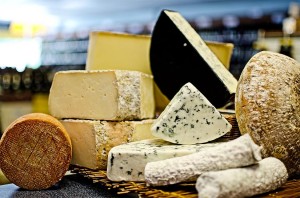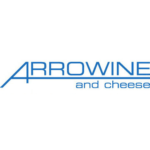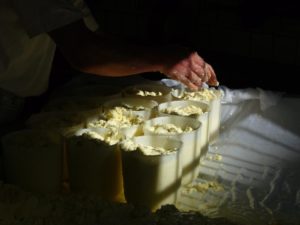Editor’s Note: This sponsored column is written by Katie Carter, cheesemonger at Arrowine (4508 Lee Highway)
 In this column, I will be writing about real cheese. I do not care much for the processed, factory made “cheese food”. My passion is for authentic cheese made with fresh milk using traditional techniques. This kind of cheese is described as artisanal, meaning it is made by a skilled artisan. It is a fascinating subject that I know you will enjoy, too.
In this column, I will be writing about real cheese. I do not care much for the processed, factory made “cheese food”. My passion is for authentic cheese made with fresh milk using traditional techniques. This kind of cheese is described as artisanal, meaning it is made by a skilled artisan. It is a fascinating subject that I know you will enjoy, too.
Cheese, simply put, is a food made from the coagulated proteins of milk. Tasty and nutritious pressed curds, basically. Throughout this column, I will show you that cheese is also more than that. Cheese is now a science, an art form, and an important culture. Every cheese is unique and every cheese tells a story.
Cheese was not invented by mankind, it was discovered. Milk is our first food but babies do not simply digest the milk; newborn stomachs actually turn that liquid nutrition into a more substantial form by coagulating the proteins and creating a semi-solid food. This food is digested slower and nutrients are absorbed better, increasing the baby’s chance of survival. This is also the case with the ruminant mammals we domesticated, which is how we discovered cheese.
Stomachs of young farm animals were once used for transporting milk long-distances. Enzymes within the stomach (chymosin, pepsin, and lipase) coagulated the milk during its journey and upon arrival, a wet, chunky mass was discovered. That is one theory of how we discovered cheese. Another possibility is that harvested milk was left by the fire one night and the warmth slowly coagulated the milk. The milk in both of those cases was most likely consumed, despite its odd appearance, and we realized that those chunky or gel-like forms seemed to keep us full for a longer period of time. Notably, it was also recognized as much gentler on our stomachs, as the people of the Neolithic times were most likely lactose intolerant and cheese contains very little lactose. Cheese became an important part of many early cultures, as it provided a long lasting form of vital nutrition.
Cheese has evolved since those early days of domestication. We now have thousands of varieties, yet the basic process of cheesemaking is the same today. We still coagulate milk using either enzymes, acid, or heat. Once the milk has coagulated and is in a gel-like state, it is cut or drained to release the liquid that is trapped in the protein matrix. This liquid is called whey, the solid pieces remaining are called curds. The curds are compacted together in a form and salt is applied in various ways. The cheese is aged for some time or consumed soon after production. It’s a simple craft that has spawned, over millennia, countless types and endless variations. Styles produced today include fresh, soft ripened (bloomy rind), washed rind, pasta filata, semi-soft, firm, blue, and flavored. Cheesemakers utilize the milk from goats, sheep, cows, water buffalo, donkeys, yak, moose, and even camels.
Cheese is constantly evolving. Right now, we are seeing a great revival in the cheese world. Traditional recipes lost to mass production are being rediscovered and innovation and creativity are blossoming. Cheese production and appreciation are growing even where cheese has never been a part of traditional diet, such as Japan and China. It is a great time to be a cheese lover! In this column, I will show you how to build a perfect cheese plate, tips on how to serve and store, and what to pair with your cheese. We’ll also get into the fun and geeky details of all sorts of cheese subjects- from the raw milk debate to the latest in cheese trends.
Until then, why not prepare a cheese plate at home? The following are some options that are tasting great this week. Keep in mind that cheese is alive, seasonal, and changes from batch to batch depending on various factors, such as the animals’ diet, time of milking, or the weather. That’s what makes artisanal cheese so special. Also, every palate is unique so you may not taste, for example, the “nuttiness” I describe. But that’s why cheese is fun, nobody is wrong in what they taste. Feel free to discuss the particular flavors and opinions of any cheese in the comments section.
Robiola Due Latte
A soft ripened cheese made with pasteurized sheep and cow’s milk from Piedmont, Italy. This is great option if you’re looking to move beyond typical Brie. The small, square shaped cheese is covered with a thin layer of bloom (edible white penicillium mold) that encases a very soft, elastic paste. It has a slightly earthy aroma and hints of a dairy farm. The flavor is mild, rich, and milky with just a bit of mushrooms.
Tomme Aydius
This unpasteurized (raw) goat’s milk cheese hails from the Valle D’Aspe in the French Pyrenees. The rind is a pretty pink hue, due to the frequent washings of the cheese, which encourages the growth of a specific (and completely edible) bacteria. The paste is firm with occasional holes. This a goat cheese for those who are skeptical of goat’s milk cheeses. While it does have a very slight flavor of goat’s milk, it is more herbaceous and nutty than anything else.
Berkswell
Made from unpasteurized sheep’s milk on a small farm in West Midlands, England, this aged, firm cheese is made in the style of the classic sheep’s milk cheeses of the Pyrenees. The aromas are biscuity and slightly lanolin-like, while the flavor is rich and nutty with a slight sweetness. It’s appearance is unique; the final cheese looks like a flying saucer due it being formed in colanders.
This is my all-time favorite blue cheese. This modern beauty is made with unpasteurized Jersey cow’s milk by a very skilled and innovative cheesemaker, Willi Schmid. It is handcrafted in a small village in Switzerland, about an hour from Zurich. The organic milk is from a tiny herd of pampered cows that graze happily on very diverse and lush pasture. The cheesemaker uses a special technique to create this blue — it is not pierced as most blue cheeses are; this cheese is literally ripped apart in order to aerate the interior to allow the mold to grow. The resulting cheese has a gorgeous marbled pattern. Rather than overpowering it, the blue penicillium roqueforti mold compliments the rich and creamy cheese.
What are your favorite cheeses right now? Share in the comments section!
Katie Carter is Arlington’s first and only ACS Certified Cheese Professional. She has worked in the cheese industry for ten years as a cheesemaker, cheesemonger, and educator. She can be found on Twitter @AfinaCheese. The views and opinions expressed in the column are those of the author and do not necessarily reflect the views of ARLnow.com.
Community discussion guidelines: Our sponsored columns are written by members of the local business community. While we encourage a robust and open discussion, we ask that all reviews of the businesses — good or bad — be directed to another venue, like Yelp. The comments section is intended for a conversation about the topic of the article.



